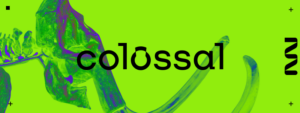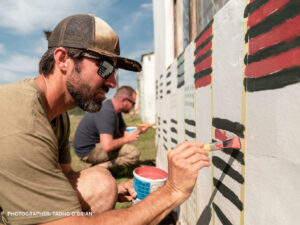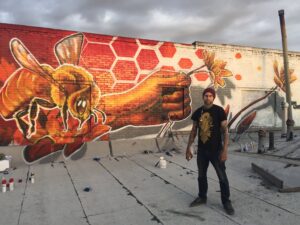AZA’s 2023 Annual Conference saw record attendance, and the Zoo & Aquarium Division of TESSERE Architecture is proud to have had seven members of its team engaging in the critical conversations that permeated committee meetings, sessions, arenas, and speakeasies. We left Columbus feeling energized and more committed than ever to advancing the collective mission of zoos and aquariums to protect and conserve wildlife and wild places.
Our key takeaways:
We Are a Mighty Powerful Force Indeed!
Stephanie Stowell, Director of Innovation & Planning
It’s Time to Define & Redefine Conservation Education.
Jen Charette, Zoo Community Impact Manager
This Is a Community That Cares for and Empowers Each Other.
Jesse Daniel, Zoo & Aquarium Division Project Coordinator
Technology Is a Tool, but Zoo & Aquarium Guests Don’t Want It to Permeate Their Visit.
Jameson Jones, Intern in Architecture
First Time Attendee
Designers Can Play an Important Role in Ensuring a Future for Birds with Avian Influenza.
Dale Stafford, Landscape Architect
Projects Are Complex, and We Need to Better Define Success Early in Design to Bring About the Best Possible Results in Animal Wellbeing, Guest Experience, and Conservation Impact.
Trisha Crowe, Project Director
We Need All Voices in the Room During All Stages of Design.
Dani Wene, Associate Landscape Architect
First Time Attendee
We Are a Mighty Powerful Force Indeed!
Stephanie Stowell, Director of Innovation & Planning
I vividly remember my very first AZA conference. The Philadelphia Zoo hosted us in 2007, and I had just accepted my first position at an AZA-accredited facility. I had spent nine years working for America’s largest conservation organization and recall my colleagues exclaiming, “Why?!” when I said I was leaving to pursue a career at my childhood zoo. As I sat in the opening-day general session in Philadelphia, I remember hearing then AZA President & CEO Jim Maddy say that AZA-accredited organizations, together, had the potential to be the most significant conservation movement in the country. And there, my friends, was my “why.” In my new role, I had the potential to engage more than 1 million people each year through direct programming and conversations, immersive guest experiences, captivating signage, and the very best part…the opportunity to get nose-to-nose with the most diverse and awe-inspiring animals you would ever hope to find…all in one place.
Sixteen years later, listening to Dr. Lanham, I was taken back to that room where I first sat wide-eyed, listening and knowing that I had found my new home with this AZA community. It was in knowing and understanding our potential and the opportunity ahead that defined my “why.” And we have accomplished so much in the past 16 years with AZA SAFE and other conservation and education partnerships that are having substantial collective impacts.
We are indeed a “mighty powerful force,” as Dr. Lanham reminded us. We are that “first-line of wilderness” and can inspire our communities to imagine and consider that a wider world exists like no one else can. And the best part is that the data from the Trends Committee reinforces that this is precisely what our communities want and expect from us. We continue to be trusted and valued community gems that our communities expect will educate and inspire, all while providing an engaging experience for them to enjoy with friends, families, and neighbors.
What conversations will we be having in the next sixteen years? How will we continue to innovate to remain relevant to those who count on us? Now that I come at this conversation from the vantage point of a supporting consultant, I think about the many ways we can all partner to implement new approaches in exhibit and experience design and in planning for the future of AZA facilities. I was inspired by Dr. Lanham’s suggestion that considering the grass growing in the crack of the sidewalk is of a higher impact than telling someone to drive 1,000 miles to experience wildness. Wildness is in our backyards…at AZA-accredited zoos and aquariums…perhaps innovation is focusing on the basics and doing it really, really well. What is our “grass in the crack of the sidewalk”? How might we refocus on simplicity to engage and inspire action?
It’s Time to Define & Redefine Conservation Education.
Jen Charette, Zoo Community Impact Manager
Integral to achieving the mission of zoos & aquariums, “education” has often been described as “everyone’s job”. And while it’s true that a united effort in delivering the message of care and conservation is crucial, it takes expertise to craft a message and methods that will be relevant, resonate, and effective with zoo and aquarium audiences. The role is complex, requiring deep understanding of learning theory, relationship cultivation, methods for creating safe spaces for people and animals, and a deep understanding of content and audience.
At this year’s conference, members of the conservation education community came together to codesign “Core Competencies” for conservation education that will communicate the unique value that a conservation education professional contributes to advancing the organization’s mission, inform equitable hiring practices, and refine and direct professional development opportunities. This conversation has immense potential to elevate, define, and even redefine the profession of conservation education.
Concurrently, it’s time for a community-wide cultural shift around the purpose of zoo and aquarium education. With the internet and apps at our fingertips, it is no longer enough for zoos and aquariums to be a source of information. We have an opportunity, and responsibility, to think beyond traditional approaches to interpretive experiences, exhibit design, and paid-programming and embrace the role of zoos and aquariums in developing critical thinkers, civic engagement, and socio-emotional learning.
The professional conservation education committee is passionate, skilled, and committed to applying their expertise to move communities to action in the care and protection of wildlife and wild places. The conversations at this year’s conference were energizing and provocative and there is much more to come!
This Is a Community That Cares for and Empowers Each Other.
Jesse Daniel, Zoo & Aquarium Division Project Coordinator
Throughout the industry, zoos and aquariums continue to grapple with the aftermath of the COVID-19 pandemic, shutdown, and subsequent workforce adjustments. While some have implemented remote work opportunities, many professionals in the field are experiencing burnout, as their boots-on-the-ground roles have remained consistently demanding. During many sessions and conversations, it became evident that a primary objective for most institutions is to enhance and rebuild their staff capacity. As seasoned experts depart from the industry, there is a growing emphasis on encouraging employees to expand their skill sets and knowledge base, a commitment that will persist over the next few years.
Institutions are actively exploring ways to provide staff with greater flexibility and opportunities for self-care (something we also noticed many engaging in during the conference proceedings). As the cloud of uncertainty gradually dissipates, I foresee a future where zoos and aquariums will emerge with a workforce that feels well-supported and empowered.
Technology Is a Tool, but Zoo & Aquarium Guests Don’t Want It to Permeate Their Visit.
Jameson Jones, Intern in Architecture
First Time Attendee
A popular topic at this year’s AZA conference was technology and its place in the future of zoos and aquariums regarding the guest experience. Does it manifest as an app on your phone that gives you a private tour of the facility? Or QR codes strategically placed on signage beckoning people to grab their phones. From an operations standpoint, technology is undoubtedly helpful for ticketing, food services, and gift stores. We also found out during the COVID-19 pandemic that it can be a valuable tool to extend the guest experience to people’s homes, extending the reach of AZA facilities further than before. However, I would challenge us to examine to what extent technology should be used and to consider potential negative impacts.
An intriguing piece of data from the Trends Committee is that when asked about the type of technology experience guests would like to see, only about 30% said they wanted to use technology to buy tickets, food, and merchandise. In fact, of the eight questions asked about the application of technology in the zoo and aquarium experience, only three broke 30%. What should be concluded from these results?
Perhaps guests are trying to tell us that the traditional experience of a zoo & aquarium should remain intact, places where one can experience the natural beauty of nature and animals without the bombardment of more technology when our world is so saturated with it.
Designers Can Play an Important Role in Ensuring a Future for Birds with Avian Influenza.
Dale Stafford, Landscape Architect
One of the most devastating viruses impacting birds within zoos and aquariums, affecting animal welfare, health, and public relations, is the Highly Pathogenic Avian Influenza (HPAI). In recent years, zoos and aquariums have grappled with the severe consequences of the spread of this deadly virus, and it is now evident that HPAI will remain a persistent threat. Facilities are faced with the need to both formulate rapid and thorough response plans when outbreaks occur in their regions and to consider long-term protective and preventative measures.
Some organizations have designated HPAI response leads and teams, creating threat-level charts to gauge the required response in the event of an outbreak. Given the virus’s enzootic nature and enduring presence akin to the flu, others have taken to actively surveying surrounding facilities, expanding monitoring beyond USDA and poultry farms.
The discussion at AZA 2023 made it clear that designers play a critical role in pursuing creative long-term architectural and site solutions to protect zoo and aquarium birds from the spread of HPAI. With the principal agents of transmission being migratory birds, deterring wild birds from utilizing water features and strategically situating bird habitats away from these water features may reduce exposure. Designers may even draw inspiration from countries like South Korea, which have wrestled with this issue for years, to incorporate protective, isolation, and quarantine areas into current and future aviaries.
By looking to the global community, sharing knowledge, and innovative planning and design, we can ensure that birds continue to be an integral part of zoos and aquariums, fostering connections in our communities and furthering critical conservation efforts.
Projects Are Complex, and We Need to Better Define Success Early in Design to Bring About the Best Possible Results in Animal Wellbeing, Guest Experience, and Conservation Impact.
Trisha Crowe, Project Director
Listening in at the two perennial exhibit design sessions (“What’s New in Exhibit Design” and “On the Boards”) at the 2023 conference in Columbus was an immensely different experience than at any other point in my career.
When I first started attending, I was finishing my degree in landscape architecture, and my main goal in life was to be a “zoo designer.” As I found my footing around AZA, however, my first opportunities came not as a designer but as an exhibits project manager at the National Aquarium in Baltimore, MD. Since then, I have spent the past seven years on the AZA-accredited owner side of projects. This was the first time I listened to these sessions through the lens of a consultant, and this broader context left me with more questions than answers. Primarily, is a project successful if it is simply better than what preceded it? Or are there minimum animal wellness standards, guest experience, and conservation connections that must be made? What makes a project great versus good?
There are as many ways to plan and execute projects as there are AZA institutions that undertake them. Whether for people or animals, projects of varying shapes and sizes come to us through facilities’ needs, capital and exhibit projects, and targeted improvements.
How each one is realized depends on various factors, chief among them budget, space, species, institution size, and staffing. Each project also has a set of goals, which almost always include some variation on improving animal wellbeing and guest experience, showing the connection of an organization’s work to larger conservation efforts and improved aesthetics. But what ultimate role do we as consultants have in helping our clients prioritize the diverse factors we all face? How have our current approaches been working, and what can we do that is new or improved?
The consultant community is rich in experience and perspective, and I look forward to ongoing conversations about the potential for a more collaborative, and thus more successful, design network. It is essential to continue to evolve our thinking about the approach to projects in zoos and aquariums to bring about the best possible results in animal wellbeing, guest experience, and conservation.
We Need All Voices in the Room During All Stages of Design.
Dani Wene, Associate Landscape Architect
First Time Attendee
During AZA 2023’s animal welfare committee sessions, a recurring theme was how critical continuous collaboration between architects, planners, and animal care professionals is to design a habitat that will advance animal wellbeing 24/7, 365. Those who have participated in developing a new habitat have been there – the initial conversations are exciting and full of aspirations for spacious, complex, and dynamic habitats, enrichment features, guest experience elements, immersive theming, and more.
And then, the realities of budget, space, and operations set in, and value-engineering begins.
Sometimes, the frontline animal care professionals who care for animals day in and day out are brought in only at the very beginning for big ideas or at the end for plan review, but their input throughout the process of balancing the complex priorities of an exhibit’s design will ensure that animal wellbeing remains at the forefront of decisions.
Conversations also made it clear that designers play an essential role in helping zoo and aquarium teams understand architectural plans and language. While features, elevations, access routes, containment strategies, materials, etc., may be clear on paper to an architect, for some, it may be their first time looking at an architectural plan. TESSERE Zoos team is uniquely positioned to support these conversations, with nine team members having worked in zoos and aquariums as animal care professionals, educators, guest experience managers, project managers, and executive team members.
In essence, balancing the complex factors of budget, space, aesthetics, and guest experience without compromising animal wellbeing in exhibit design is an ongoing challenge. With all voices at the table, we can ensure that animal wellbeing is always at the forefront of decisions, even during nighttime care, and maintain the integrity of zoos and aquariums as leaders in animal wellbeing and as educational and conservation institutions.




